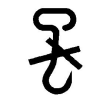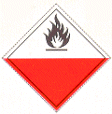| Combed top | [German version] |
Table of contents |
|
| General: | ||
| Product information | ||
| Packaging | ||
| Transport | ||
| Container transport | ||
| Cargo securing | ||
Product information
Product name
| German | Kammzug, Kammwolle, Wolle gewaschen |
| English | Combed top |
| French | Laine Peigné |
| Spanish | Lana peinada |
| CN/HS number * | 51 ff. |
(* EU Combined Nomenclature/Harmonized System)
Product description
Wool (sheep’s wool), a protein fiber, is the highest value textile fiber. The main factor in determining the value of a fleece is its pure wool content. Depending on cleanness, a distinction is drawn between the following types:
| greasy wool, unscoured wool | |
| scoured wool | |
| snow white wool |
Combed top (combed wool) is washed and combed long-fiber raw wool which is used as a starting material for worsted spinning mills. Combed top is a flat sliver of wool of an average length of 6 cm which is preferably converted into worsted yarn (in contrast to the lofty carded wool, which is converted into carded yarn). Combed top is supplied in grades classed by fineness, length and strength.
Wool fibers consist of a cellular structure of keratin covered with scales. A schematic cross-section through a wool fiber reveals the following structure:
The scale layer consisting of keratinized protein cells protects the inside of the fiber and is one of the factors responsible for wool’s felting property and thus for its good warmth retention properties. The fine, resilient intermediate membrane (basal membrane) allows both dyes and moisture to penetrate into the wool fiber. The cortical cell layer (cortex) forms the body of the fiber. It influences important characteristics such as strength, stretch, elasticity and crimp. The medulla is responsible for feeding the wool fiber and does not contribute in any way to its strength.
Wool is classified by:
| breed and wool quality | |
| recovery method | |
| body part and fineness | |
| cleanness | |
| hair type | |
| gender and age | |
| Origin | |
| production purpose |
Breeds are divided into three groups:
| Breed group | Wool formation | Wool qualities | Production suitability |
|---|---|---|---|
| 1. Highland sheep | The sheep live at high altitudes, their hair developing as a protection against the cold. | Very fine, highly crimped, soft, short wool | Suitable for carded yarn production |
| 2. Lowland sheep | The sheep live at low altitudes, their hair developing as a protection against rain. | Strong, relatively uncrimped, lustrous, long wool | Suitable for worsted yarn production |
| 3. Crossbred sheep | Crosses between highland sheep (ewes) and lowland sheep (rams) | Medium fine, moderately crimped, medium length wool | Suitable for carded and worsted yarn production |
Quality / Duration of storage
Spinnable animal hair obtained as a fleece by shearing and distinguished by certain properties (e.g. fineness, crimp, stretch, length, felting property); a distinction is drawn between shear wool (highest quality), pelt or slipe wool (from skins of slaughtered healthy animals, somewhat lower quality) and fallen wool (poorest quality).
Wools with a well developed medulla are coarse, wools lacking a medulla being in great demand. Medium fine wools have only residual „islands“ of medulla while the finest wool fibers have no medulla at all.
Intended use
Most combed top is processed to yield worsted yarn.
Figures
(Click on the individual Figures to enlarge them.)
 Figure 1 |
 Figure 2 |
 Figure 3 |
Countries of origin
This Table shows only a selection of the most important countries of origin and should not be thought of as exhaustive.
| Europe | |
| Africa | South Africa |
| Asia | Pakistan, Lebanon |
| America | Argentina, Brazil, Uruguay, Chile |
| Australia | Australia, New Zealand |
Back to beginning
Packaging
Combed top is packaged in bales (approx. 200 kg to 450 kg) with wrapping of jute and/or plastic fabric, plastic film or packing paper and held together with steel strapping or wires.
| Marking of packages | ||
 Keep dry |
 Use no hooks |
 Keep away from heat (solar radiation) |
Back to beginning
Transport
Symbols
 General cargo |
 Spontaneously combustible, Fibers of animal origin: Class 4.2 IMDG Code and ADR |
Means of transport
Ship, truck, railroad, aircraft
Container transport
According to [11], closed standard containers are suitable for both raw wool and cleaned wool, subject to compliance with water content of goods, packaging and flooring.
Cargo handling
In damp weather (rain, snow), the cargo must be protected from moisture, since wool is strongly hygroscopic and readily absorbs moisture.
Hooks should not be used, since they may lead to sparking when they come into contact with the metal strapping.
Stowage factor
| 3.54 – 6.79 m³/t (bales, uncompressed) [1] | |
| 3.20 – 4.20 m³/t (bales, jute fabric, steel strapping, uncompressed) [1] | |
| 1.42 – 3.11 m³/t (bales, compressed) [1] |
Stowage space requirements
Dry, clean holds from which feedstuff residues have been removed, without oily areas; pipework must be leak-proof.
Segregation
Fiber rope/thin fiber nets (preferred). Chalk marking of the bales has also proved effective. Do not stow washed wool together with raw wool, fallen wool and other greasy grades of wool.
Bales intended for different ports must be strictly segregated when stowed, as symbols, numbers and port marks on wool bales are easily confused.
Cargo securing
The cargo is to be stowed in such a way that the bales or strapping are not damaged. Undamaged strapping is essential to maintain compression of the bales during transport. If the strapping is broken, compression is diminished, which at the same time results in an increased supply of oxygen to the inside of the bales. This in turn increases the risk of combustion or feeds a fire which has already started.
Back to beginning
Risk factors and loss prevention
RF Temperature
Combed top requires particular temperature, humidity/moisture and possibly ventilation conditions (SC VI) (storage climate conditions).
Favorable travel temperature range: 5 – 25°C [1]
Every hold should be equipped with means for measuring temperature. Measurements must be performed and recorded daily.
Back to beginning
RF Humidity/Moisture
Combed top requires particular temperature, humidity/moisture and possibly ventilation conditions (SC VI) (storage climate conditions).
| Designation | Humidity/water content | Source |
| Relative humidity | 65% | [1] |
| Water content | 17 – 18.2% | [1] |
| 18 – 25% | [9] | |
| Maximum equilibrium moisture content | 65% | [1] |
Wool exhibits particularly marked hygroscopicity. The water content is subject to considerable fluctuations depending on relative humidity (in temperate latitudes between 12 and 20%). Wool may absorb up to 40% atmospheric water vapor without feeling damp. It thus has the highest water vapor absorption capacity of all textile fibers. It is therefore recommended that moisture measurements be carried out upon acceptance of a consignment.
Moisture-damaged bales must be rejected, as wetness (seawater, rain, condensation water) cause discoloration, brittleness, mold, mildew stains, mustiness, self-heating and corrosion under the metal strapping. Exposure to seawater in particular causes mildew-staining and yellowing of the wool and impairs dyeing characteristics (severe depreciation). Wool must not be stowed in a hold/container together with hygroscopic goods (e.g. fresh lumber, damp ores).
Cargo fires must not be extinguished with water, as wool’s enormous swelling capacity may lead to considerable damage. Water absorption may cause wool to grow in volume by up to 30%. CO2 should be used to extinguish fires.
Excessive internal moisture is not detectable externally on the wrapping. If moisture damage is found inside the bales (strong musty odor) without any signs of damp on the wrapping, the water content may have been too high at the time of baling.
 Figure 4 |
Back to beginning
RF Ventilation
Combed top requires particular temperature, humidity/moisture and possibly ventilation conditions (SC VI) (storage climate conditions).
When implementing ventilation measures, it must be borne in mind that wool bales rapidly absorb water vapor.
Air exchange rate: 6 changes/hour (airing)
No access is permitted to the hold until it has been adequately ventilated and the CO2 or O2 content of the hold air measured with a gas detector.
Back to beginning
RF Biotic activity
Combed top displays 3rd order biotic activity.
Combed top is a product in which respiration processes are suspended, but in which biochemical, microbial and other decomposition processes still proceed.
Back to beginning
RF Gases
The increase in CO2 and CO content indicates a cargo fire. The TLV for hold air CO2 concentration is 0.49 vol.%. The normal O2 content of air is 20.95 vol.%.
Back to beginning
RF Self-heating / Spontaneous combustion
Oil content: 2 – 5% (wool grease)
Combed top is an animal fiber. Animal fibers (burnt, wet or damp) are assigned to Class 4.2 (Substances liable to spontaneous combustion) of the IMDG Code and ADR.
Combed top may readily be set alight by sparks, cigarette ends etc.. Wool’s high keratin content also makes it liable to self-heating; spontaneous combustion may occur due to moisture and fats/oils. Do not stow this product together with foodstuffs and animal feed or with animal or vegetable fats/oils. Oil-saturated wool quickly succumbs to self-heating/spontaneous combustion and may burn for weeks without being discovered. Do not stow combed top over barrels containing wool grease, as this also produces a risk of spontaneous combustion. Smoking is absolutely prohibited.
The hold must be equipped with a CO2 installation, as water is unsuitable for extinguishing a fire due to the considerable damage caused to the cargo and the capacity of wool to swell by 30%.
A fire in combed top, usually accompanied by extinguishing water and contamination by foreign bodies, causes considerable losses. Any decision as to whether processing the combed top will result in reasonable residual values must be made on a case by case basis taking account of costs and the state of the damaged combed top.
Back to beginning
RF Odor
| Active behavior | Combed top has a slight, unpleasant odor. When heated, combed top melts and releases an unpleasant odor of burnt keratin. Bales which are excessively damp on the inside produce a musty, ammonia-like odor. |
| Passive behavior | Combed top is sensitive to unpleasant and pungent odors. |
Back to beginning
RF Contamination
| Active behavior | Combed top does not cause contamination. |
| Passive behavior | Contamination of combed top occurs due to tearing or chafing of the bales, which weigh up to 450 kg. Any damage to the combed top results in relatively severe reductions in value or, if necessary, additional costs for recombing After mill washing, snow white wool has a residual contaminant content of only 2 – 5%. Contamination of bales is primarily due to tearing of the wrapping. Severely soiled combed top must be recombed (additional costs and severe depreciation). Oil-stained bales must be rejected because of the risk of self-heating. Rust contamination of the product hampers the spinning process. Combed top must not be stowed together with unwashed wool because, on exposure to pressure and heat, such wool releases wool grease, a brown, viscous liquid which may soil the washed wool. |
Back to beginning
RF Mechanical influences
Combed top is particular susceptible to mechanical damage by hooks and forklift trucks. Snapping, chafing and breaking of the steel strapping result in tearing of wrappings, losses of volume and contamination.
Back to beginning
RF Toxicity / Hazards to health
A disinfection certificate is necessary. People who pick up combed top with their bare hands may be infected by the anthrax bacillus (Bacillus anthracis) and develop anthrax.
Eating, chewing tobacco and taking snuff are prohibited when working with animal substances. Wash and disinfect hands before eating. Always wear gloves to pick up combed top.
Back to beginning
RF Shrinkage/Shortage
Loss of volume occurs due to bursting of bales (usually at the top) during cargo handling. One frequent consequence of such damage is soiling of the combed top. The usual, but excessively bulky, commercial packaging, which weighs up to 450 kg (e.g. Uruguay, Argentina), is often responsible for soiling or loss of volume. From the outside, the bales cannot be distinguished from bales of wool from the same country of origin and they seldom provide any indication of the sensitivity of the contents. The only way to achieve a considerable reduction in the losses arising from these causes is to reduce the weight of these bales to approx. 250 kg. Alternatively, the product could be packaged in two layers of jute.
Loss of volume is also caused by counting errors, therefore keep a careful tally.
Back to beginning
RF Insect infestation / Diseases
Insect infestation may occur prior to shipment, but may also be passed on by accompanying cargo. The combed top has then to be fumigated. During storage, bales are particularly prone to attack by keratin-destroying insects, such as moths (clothes moths, carpet moths) and beetles (carpet beetles, fur beetles), but they may also become infested with silverfish and termites.
Damp bales may also develop mildew due to mold and mildew stains due to bacteria.
A fumigation certificate and certificate of origin may have to be enclosed with the shipping documents.
Back to beginning
Additional information
Additional types of wool:
Angora wool (angora hair, mohair wool):
Angora wool, also known as mohair, is the wool (hair) of the angora goat or angora rabbit. It is a valuable raw material for the textiles industry.
Countries of origin: Turkey, Russia, South Africa, USA, China etc..
Stowage factors:
| Bales, compressed | 3.39 m3/t [1] |
| Bales | 4.53 – 7.22 m3/t [1] |
Odor: often releases an unpleasant odor, so should not be stowed together with fine products.
Shoddy (regenerated wool):
Shoddy is woolen fiber obtained by shredding old and new woolen rags.
Stowage factor, highly variable:
| Bales | 3.54 – 4.39 m3/t [1] |
| Bales, compressed | approx. 2.12 m3/t [1] |
Subject to self-heating on exposure to moisture; spontaneous combustion on exposure to animal and vegetable fats/oils.
Shoddy must be cleaned and disinfected. A disinfection certificate is necessary.
Maximum water content is 12%.
Pelt wool (pulled wool):
Pelt wool is the raw material for producing felt from the pelts of various mammals (e.g. hare, rabbit, otter, badger, goat).
Stowage factors:
| Bales | 6.94 m3/t [1] |
| Boxes | 5.95 m3/t [1] |
Odor: Often causes severe odor-tainting.
Pelt wool is subject to spoilage not only by moisture and oils, but also by insects and should thus be stowed well away from fine products.
Wool waste:
Wool waste is waste generated by spinning or weaving mills and finishing operations. A distinction is drawn between worsted and carded waste.
Like raw wool (greasy wool) and washed wool, wool waste is highly susceptible to self-heating. If wool waste is impregnated with fat/oil, spontaneous combustion may occur. Since such waste is very frequently contaminated with oils in industrial operations, it should be cleaned repeatedly before being packaged in bales. A letter from the consignor guaranteeing that wool waste has been cleaned and that oil is present at most in a quantity of < 5% is thus usually required.
Stowage factors:
| Bales | approx. 4.53 m3/t [1] |
Odor: Wool waste often releases an unpleasant odor.
Back to beginning
